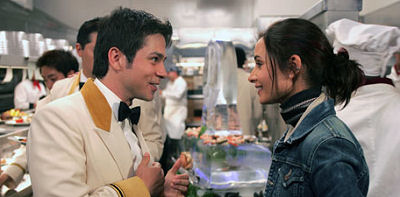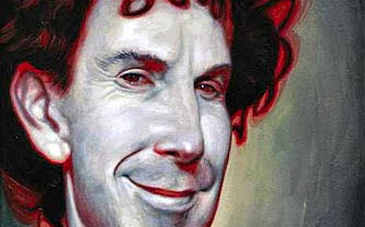My interview piece with Alejandro Gonzalez Innaritu, the director of Babel, went up Sunday night and yet it’s been pushed down by other stories and items fairly quickly since then. I just want to make sure it has its day in the sun.
Day: May 15, 2006
Travelling day today….I leave JFK for Paris at 5:30 pm, arriving in Paris around 6 ayem, and then taking an Easy Jet to Nice a couple of hours later. No more postings between now and sometime around 7 ayem Tuesday morning, New York time. At the earliest, I mean…
Who Dies?
Not to take disaster or ensemble action films too seriously, but there are cultural reasons why certain characters die in films of this sort. There’s a literal pecking order, in fact, and Poseidon — a casualty itself — shows how it works.
The bottom line (and here comes the SPOILER that I warned readers about twice last week) is that two of the four people who die among Poseidon‘s small survivor group — Freddy Rodriguez and Mia Maestro — are Hispanic, and I think their blood is what seals their fate.

Poseidon‘s Freddy Rodriguez, Mia Maestro
I could shilly-shally all over the place about unconscious racism and how Poseidon‘s screenwriter Mark Protosevich and director Wolfgang Petersen are probably more forward-minded than most of us about racial matters, but I still say that Rodriguez and Maestro die in this film not just because they’re not big-enough stars, but also because Hispanics are considered to be culturally expendable.
I forget the name of the black comic (is it Chris Rock?) who does a routine about any time there’s a black guy among a group of kids in a horror film, you can count on his getting killed fairly quickly. This routine always gets a laugh because people know that it’s true, and I think a similar attitude has come through in Poseidon about Latinos.
< ?php include ('/home/hollyw9/public_html/wired'); ?>
Here’s how the disaster-film death system works, more or less…
The highest ranked is the self-sacrificing hero. He is always male, always played by a star, and he always buys it in the third act while trying to save others. Gene Hackman died this way in the original 1972 Poseidon, and a name-value actor dies this way in the present version.
The second death level is shared by two types — the selfish lout and the weak second-banana who can’t hack it.

Mia Maestro
Kevin Dillon is Poseidon‘s resident blowhard, and you can tell he’s a goner from the moment he takes out his hip flask and takes a sip. If Maestro was not Agentinian she would be a good death candidate anyway because she plays the weakling of the group (i.e., unable to handle being in tight places). And yet Carol Lynley played a weakling in the 1972 version and lived.
The third candidates for the Great Beyond, as noted, are culturally expendable non-whites.
Gays used to be considered expendable or disposable — you can feel this attitude in genre movies of the ’60s — but they’ve moved up in the world to the extent that screewriters don’t dare kill them off or make them dislikable or villainous.
Rodriguez’s death inside an elevator shaft is arguably Poseidon ‘s most jarring moment.
His character, a busboy, is shown to be a brave and intelligent man, but then a metal table he’s standing on inside an elevator shaft gives way and he’s forced to cling to the leg of Richard Dreyfuss, a broken-hearted gay industrialist. Dreyfuss, in turn, is being held by star Josh Lucas. Lucas isn’t strong enough to pull Dreyfuss and Rodriguez to safety so he says to Dreyfuss, “Shake him off or you’ll both die!” And Dreyfuss finaly does.

Freddy Rodriguez, Eva Longoria
What if it had been Rodriguez shaking Dreyfuss off? That would have made for an even more startling scene. But Dreyfuss is a better-known actor than Rodriguez at this stage of the game ( Six Feet Under aside), and he probably got paid more, and he’s white…so Rodriguez had to die. But the way he’s gotten rid of is not just sadistic but disrespectful.
I was hoping that one of Poseidon‘s attractive white youths would die — Emmy Rossum, Jacinda Barret, Mike Vogel — or even the token kid, played by Jimmy Bennett. But the Death Rules state that the young must survive in order to go out in the world and procreate and propulgate the species.
A friend sold me on the culturally expendable idea a couple of weeks ago. I was initially skeptical but the more I thought about it the more convinced I became.
I ran it by Alejandro Gonzalez Innaritu and he said, “Of course! Of course!” I also ran it by a few Hispanic media types and journalists (American Entertainment Marketing’s Yvette Rodriguez, Jorge Camara of La Opinion, the National Hispanic Media Coalition’s Alex Nogales, Miami Herald film critic Rene Rodriguez) but we missed each other or they didn’t have much to say.
If anyone wants to chime in…
Another tribute piece to the great Charlie Kaufman, a screenwriter (Adaptation, Being John Malkovich) propelled by a kind of perverse impudence and irreverence. This profile is better than most and has been written by L.A. Times contributor David L. Ulin .

“If the [Cannes Film Festival] does not take itself seriously enough to use what power it still has to move the quality agenda forward, why would anyone else? (That is, outside of journalists who love getting a free trip to the South of France each year.) The truth is [that] Cannes has become far worse than Sundance in terms of selling out. Yet the unfamiliarity seems to be a condom from the contempt that has infected so many journalists and critics in recent years. And the studios are happy to be welcomed to abuse the credibility of the festival and to use it mercilessly as a platform to market their big, but not necessarily fine, movies to the more-important-than-home-in-many-cases European and world market.” — a not-unfair criticism from David Poland, a perennial non-attender who gets it on one level and misses it profoundly at the same time. The Cannes Film Festival exists and is trying to thrive in the world that we have made. That world, lamentably, includes gala screenings of Brett Ratner‘s X-Men 3: The Last Stand, but Cannes isn’t a hideaway haven like Telluride or the Bermuda Film Festival, and Poland finds that objectionable. I agree with him — there should be more aesthetic purity in the world — but he never goes to Cannes and I think you have to do that to get what it is and what it signifies. To roll with the film festival aesthetic of 2006 you need to be, on some level, a film-buff equivalent of a moral relativist . You can’t just sit on your squishy couch in Los Angeles and go, “Nyah-nyah.” You have to get on the plane, do the 18-hour days, sip the cappucino, file the stories and reviews and generally tough the whole thing out. Then and only then…
I haven’t seen Werner Herzog’s Rescue Dawn, but trust me (and you won’t need to take my word for it once you see it), this trailer is a very vague and misleading representation of what the film almost certainly is. The cutting, the bullshit slogans, the Apocalyose Now-styled percussion — it’s the same old shit, and s.o.s. is what you never get from a Werner Herzog film. This trailer is a marketing jerkoff’s idea of what he-she thinks (or what his-her agency boss thinks) will appeal to the schmucks out there looking to enjoy a standard-issue Vietnam-era prisoner-of-war escape drama. (Which isn’t to say Rescue Dawn will utterly ignore or wave off the expecations of this crowd.) Memo to marketing jerkoff: Werner Herzog’s films are never less than transcendent or stunning or cinematically challenging in the best way imaginable. Your efforts at trying to sell this film are predictable and understandable, but compared to Herzog’s vision and artistry your mentality is that of a fly sitting on the neck of a lion.
In tribute to the opening of Sydney Pollack‘s Sketches of Frank Gehry (Sony Classics, 5.19), which is easily one of the most spiritually uplifting films you’ll see this year (and I mean this), I did a phoner with Pollack a couple of weeks ago to recap and go over things.

The sound file is sufficient, but here’s the piece I did eight months ago after first seeing Sketches at the Toronto Film Festival. I called it “a stirring, hugely likable portrait of the most daring and innovative architect of our time,” and said that “as corny as this sounds, Sketches left me with a more vivid feeling of celebration and with more reasons to feel enthused and excited about life than anything I’ve seen so far at this festival. It’s a film that lets you into the head of a genius in a very relaxed and plain-spoken way, and it lets you share in the sense of being a person of Gehry’s magnitude — a guy who has created a kingdom out of a supreme confidence in his dreams, but at the same time someone honest enough to admit he doesn’t precisely know what he’s doing much of the time. This is partly due to Gehry having been very open and unguarded with Pollack as the doc was being shot, and partly due to Pollack having sculpted this film in a way that feels more personal and congenial and relaxed than your typical portrait-of-a-noteworthy-person movie. And yet Pollack doesn’t relent in passing along all the information we need to know about Gehry. It’s all done with total thoroughness and clarity of purpose.”
One presumes that N.Y. Times reporter Sharon Waxman is always multitasking and going a little bit crazy from this, hence her interest in writing this piece about a marketing study of how and why people multi-task, and who gains and loses in terms of serious focus and attention. And my eyes….glazed…over. Reading it was like taking Percocet; I felt increasingly shrouded in mist and fog and a keen sense of space-time discontinuum. I’m still fogbound as I write this…help!
Hollywood’s bathroom-break age-divide issue, as it affects the summer blockbuster season. Christopher Noxon‘s N.Y. Times piece eventually segues into discussing the always elusive, revenue-bestowing films known as kid-adult hybrids .
